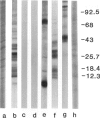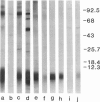Abstract
Individual human Ig class responses to Onchocerca volvulus antigens have been evaluated by Western blotting using sera from cases of generalized onchocerciasis and chronic hyper-reactive onchocerciasis (Sowda). in all cases except IgG3 the patterns of recognition by human antibody classes were similar in Sowda and generalized onchocerciasis. Weak or undetectable responses were seen with IgG1, IgG2 and IgM. The total profiles of antigens recognized by the other Ig classes were different, although in some cases certain bands were commonly identified. The result with IgG3, however, was striking. Here, two major antigens (9 kD and 72kD) were recognized by IgG3 antibodies in Sowda sera but not generalized onchocerciasis sera. Furthermore, these two antigens were not recognised by any other Ig class, either in generalized or Sowda onchocerciasis, nor were they detected by antibodies of any class present in a collection of sera representative of other nematode infections. This difference in the IgG3 response was so pronounced that Sowda sera could be distinguished from generalized onchocerciasis sera by an IgG3-specific ELISA assay with a PBS parasite extract as the antigen. Thus, a correlation has been established between one particular clinical condition of onchocerciasis (Sowda) and a serological response, defined in terms of both the parasite antigens and an immunoglobulin class restricted antibody response.
Full text
PDF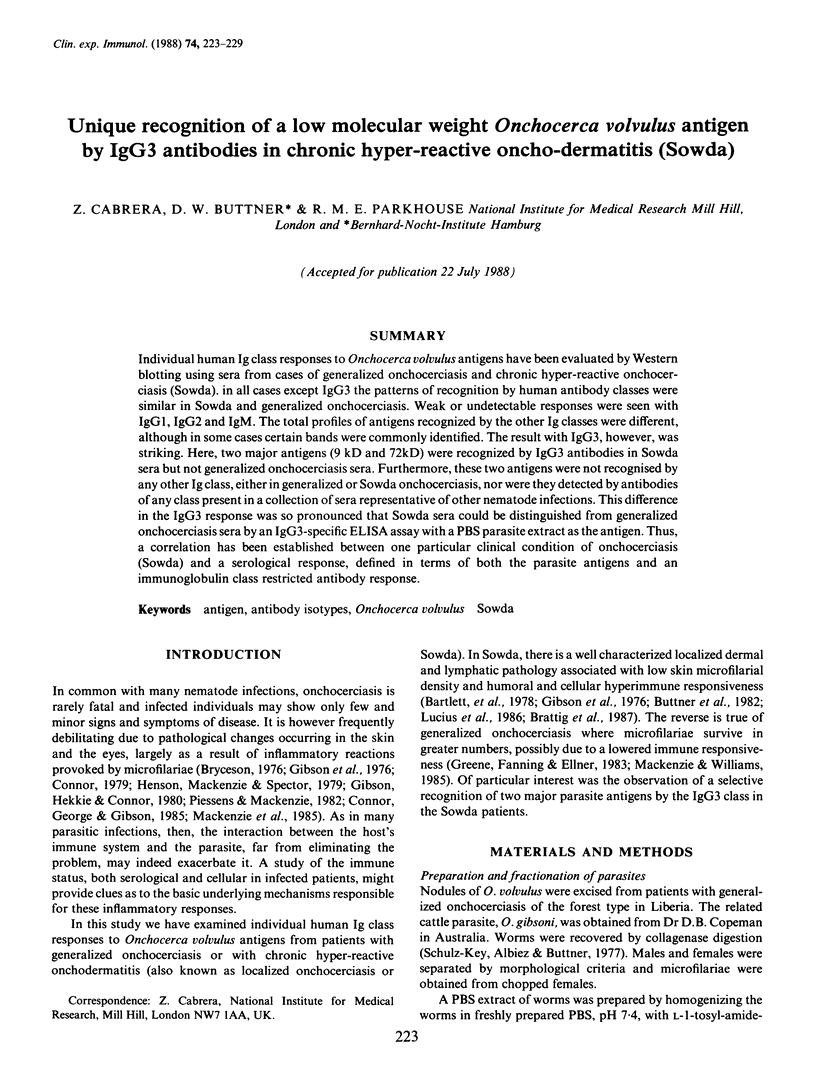

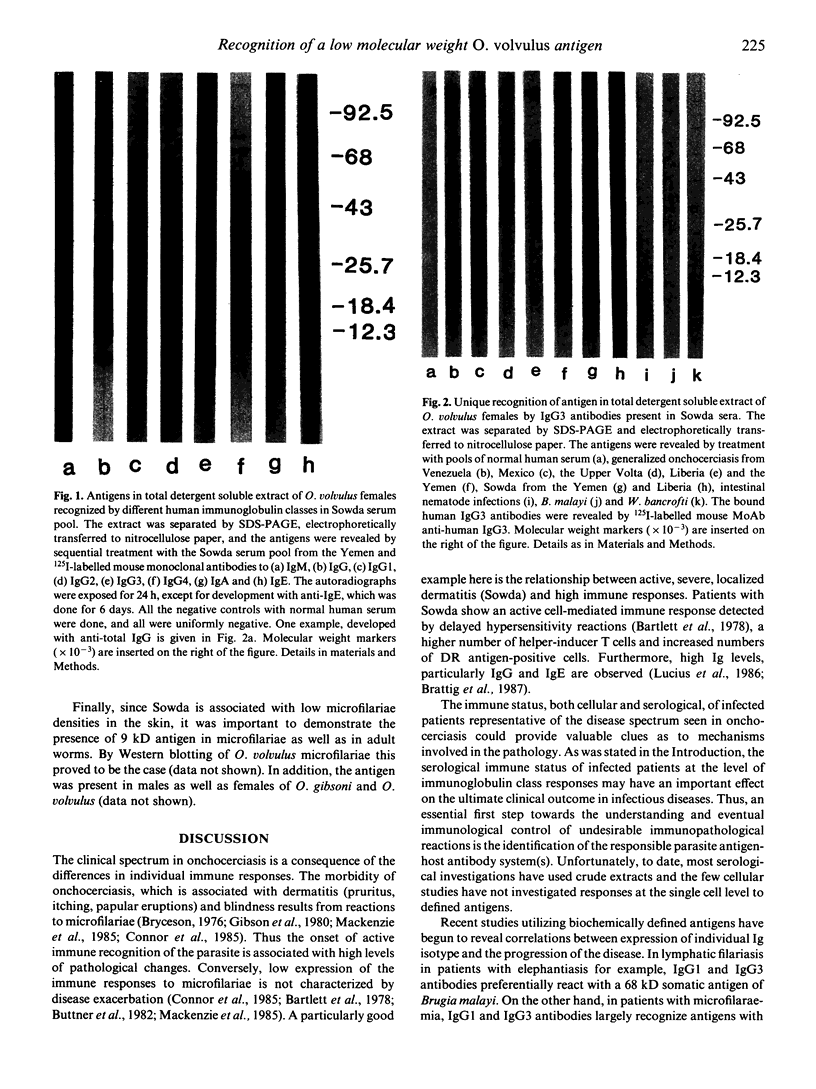
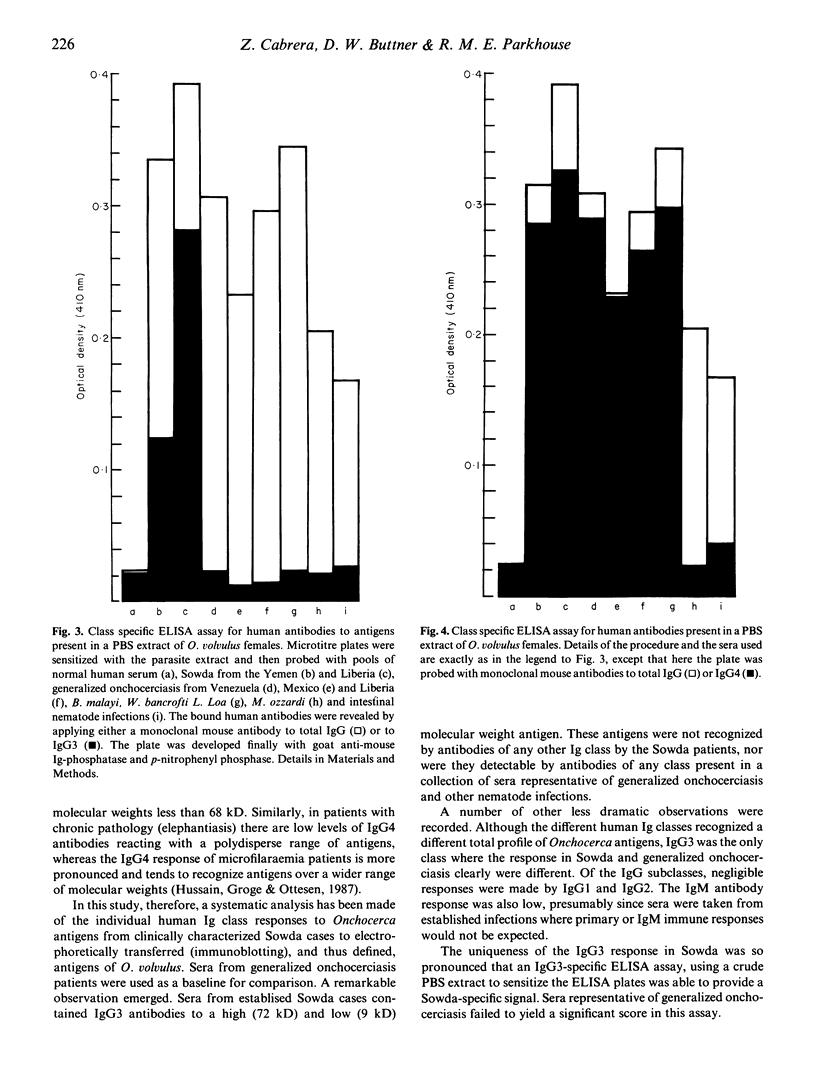
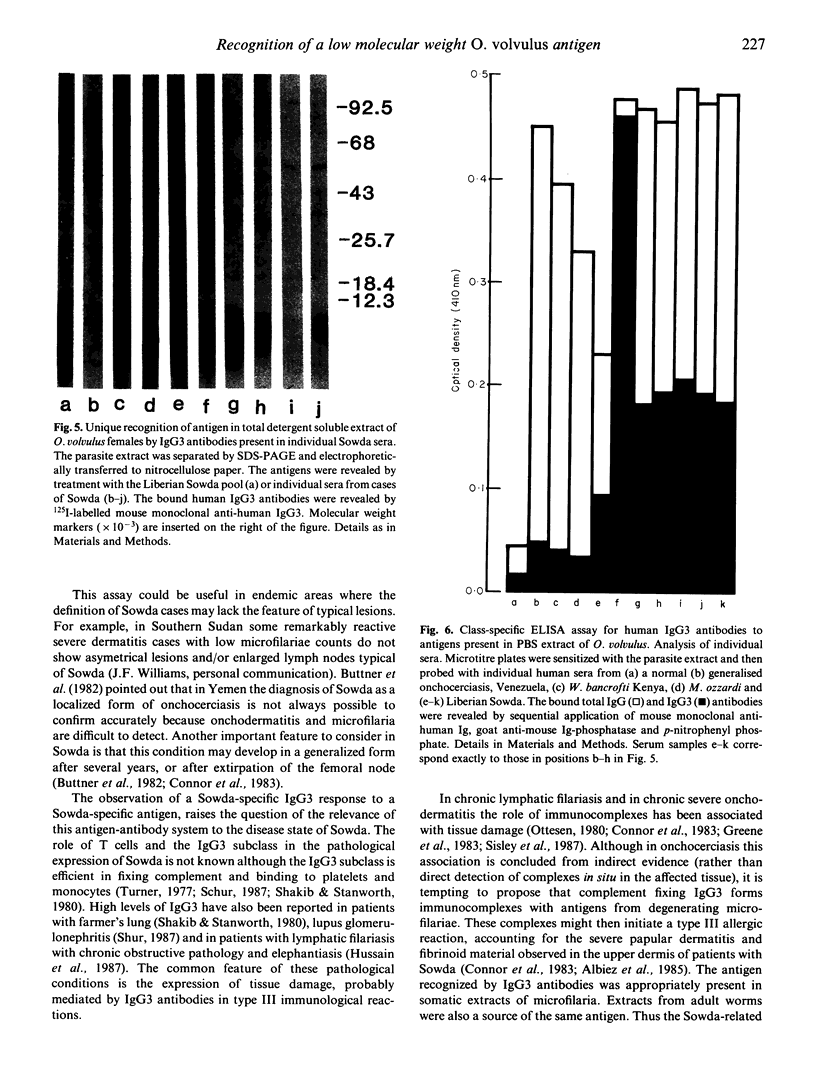
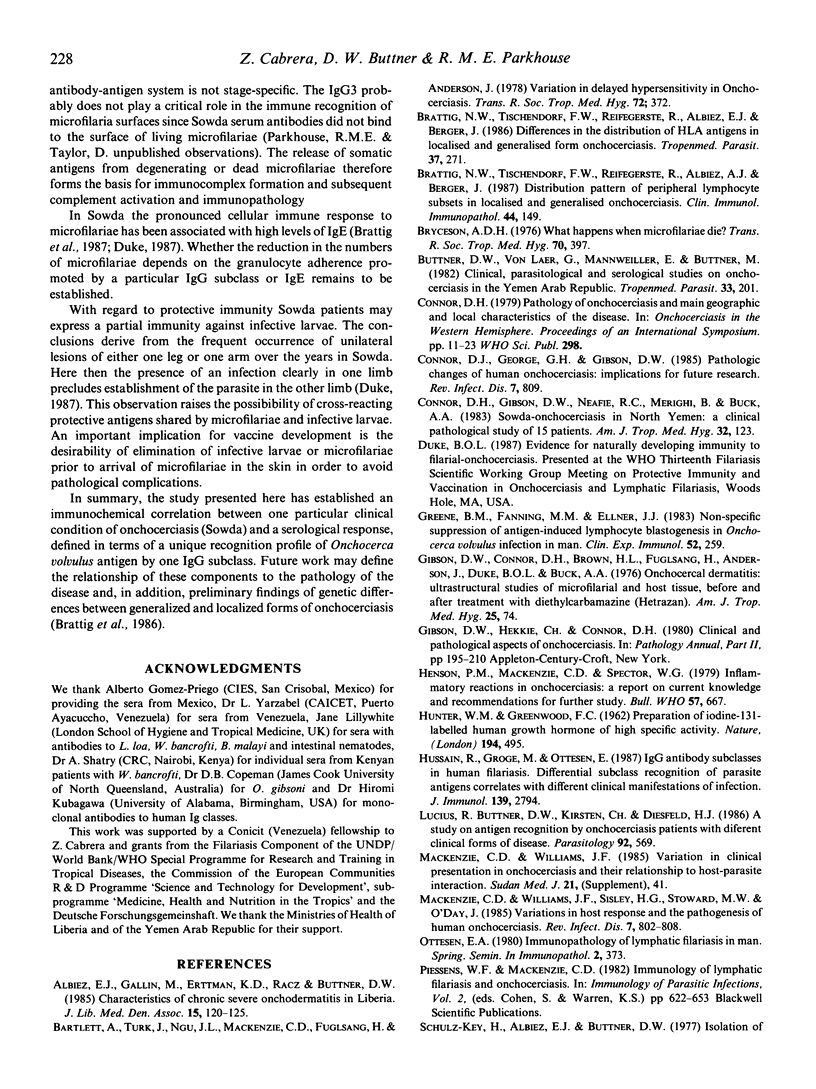
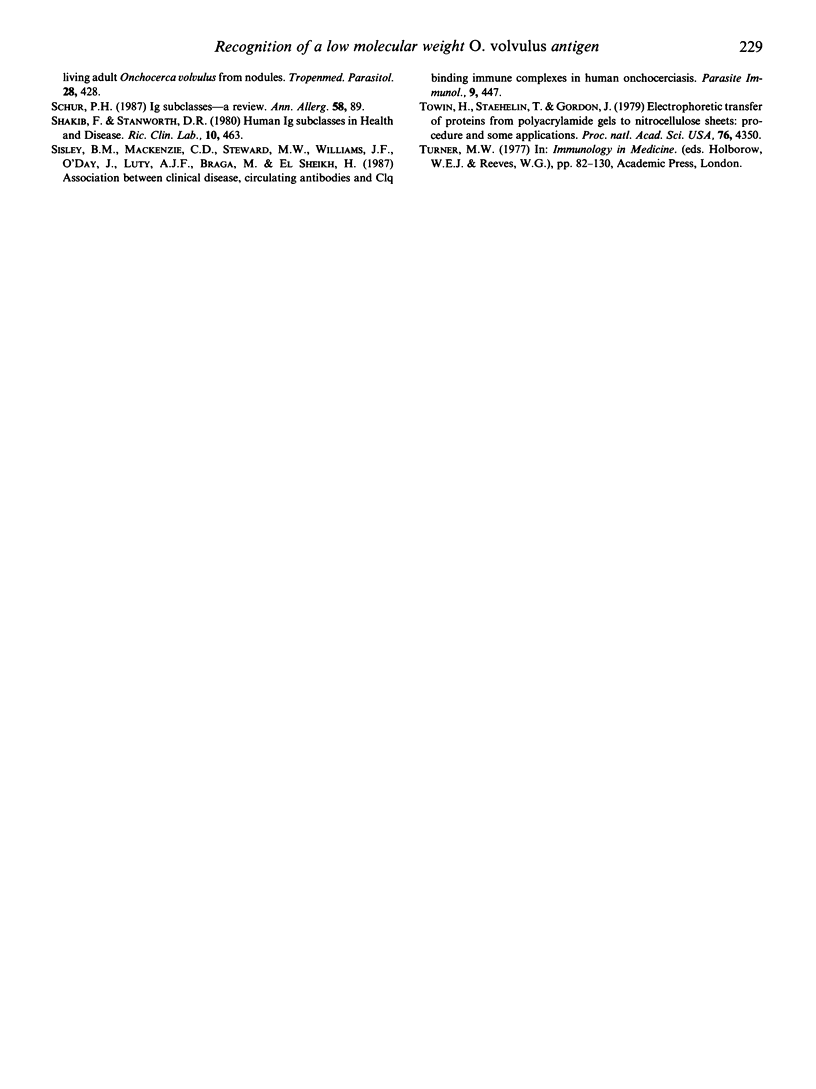
Images in this article
Selected References
These references are in PubMed. This may not be the complete list of references from this article.
- Bartlett A., Turk J., Ngu J., Mackenzie C. D., Fuglsang H. Variation in delayed hypersensitivity in onchocerciasis. Trans R Soc Trop Med Hyg. 1978;72(4):372–377. doi: 10.1016/0035-9203(78)90130-x. [DOI] [PubMed] [Google Scholar]
- Brattig N. W., Tischendorf F. W., Albiez E. J., Büttner D. W., Berger J. Distribution pattern of peripheral lymphocyte subsets in localized and generalized form of onchocerciasis. Clin Immunol Immunopathol. 1987 Aug;44(2):149–159. doi: 10.1016/0090-1229(87)90062-6. [DOI] [PubMed] [Google Scholar]
- Brattig N. W., Tischendorf F. W., Reifegerste S., Albiez E. J., Berger J. Differences in the distribution of HLA antigens in localized and generalized form of onchocerciasis. Trop Med Parasitol. 1986 Sep;37(3):271–275. [PubMed] [Google Scholar]
- Bryceson A. D. What happens when microfilariae die? Trans R Soc Trop Med Hyg. 1976;70(5-6):397–401. doi: 10.1016/0035-9203(76)90117-6. [DOI] [PubMed] [Google Scholar]
- Büttner D. W., von Laer G., Mannweiler E., Büttner M. Clinical, parasitological and serological studies on onchocerciasis in the Yemen Arab Republic. Tropenmed Parasitol. 1982 Dec;33(4):201–212. [PubMed] [Google Scholar]
- Connor D. H., George G. H., Gibson D. W. Pathologic changes of human onchocerciasis: implications for future research. Rev Infect Dis. 1985 Nov-Dec;7(6):809–819. doi: 10.1093/clinids/7.6.809. [DOI] [PubMed] [Google Scholar]
- Connor D. H., Gibson D. W., Neafie R. C., Merighi B., Buck A. A. Sowda--onchocerciasis in north Yemen: a clinicopathologic study of 18 patients. Am J Trop Med Hyg. 1983 Jan;32(1):123–137. doi: 10.4269/ajtmh.1983.32.123. [DOI] [PubMed] [Google Scholar]
- Gibson D. W., Connor D. H., Brown H. L., Fuglsang H., Anderson J., Duke B. O., Buck A. A. Onchocercal dermatitis: ultrastructural studies of microfilariae and host tissues, before and after treatment with diethylcarbamazine (Hetrazan). Am J Trop Med Hyg. 1976 Jan;25(1):74–87. doi: 10.4269/ajtmh.1976.25.74. [DOI] [PubMed] [Google Scholar]
- Gibson D. W., Heggie C., Connor D. H. Clinical and pathologic aspects of onchocerciasis. Pathol Annu. 1980;15(Pt 2):195–240. [PubMed] [Google Scholar]
- Greene B. M., Fanning M. M., Ellner J. J. Non-specific suppression of antigen-induced lymphocyte blastogenesis in Onchocerca volvulus infection in man. Clin Exp Immunol. 1983 May;52(2):259–265. [PMC free article] [PubMed] [Google Scholar]
- HUNTER W. M., GREENWOOD F. C. Preparation of iodine-131 labelled human growth hormone of high specific activity. Nature. 1962 May 5;194:495–496. doi: 10.1038/194495a0. [DOI] [PubMed] [Google Scholar]
- Henson P. M., Mackenzie C. D., Spector W. G. Inflammatory reactions in onchocerciasis: a report on current knowledge and recommendations for further study. Bull World Health Organ. 1979;57(5):667–682. [PMC free article] [PubMed] [Google Scholar]
- Hussain R., Grögl M., Ottesen E. A. IgG antibody subclasses in human filariasis. Differential subclass recognition of parasite antigens correlates with different clinical manifestations of infection. J Immunol. 1987 Oct 15;139(8):2794–2798. [PubMed] [Google Scholar]
- Lucius R., Büttner D. W., Kirsten C., Diesfeld H. J. A study on antigen recognition by onchocerciasis patients with different clinical forms of disease. Parasitology. 1986 Jun;92(Pt 3):569–580. doi: 10.1017/s0031182000065458. [DOI] [PubMed] [Google Scholar]
- Mackenzie C. D., Williams J. F., Sisley B. M., Steward M. W., O'Day J. Variations in host responses and the pathogenesis of human onchocerciasis. Rev Infect Dis. 1985 Nov-Dec;7(6):802–808. doi: 10.1093/clinids/7.6.802. [DOI] [PubMed] [Google Scholar]
- Schulz-Key H., Albiez E. J., Büttner D. W. Isolation of living adult Onchocerca volvulus from nodules. Tropenmed Parasitol. 1977 Dec;28(4):428–430. [PubMed] [Google Scholar]
- Schur P. H. IgG subclasses--a review. Ann Allergy. 1987 Feb;58(2):89-96, 99. [PubMed] [Google Scholar]
- Shakib F., Stanworth D. R. Human IgG subclasses in health and disease. (A review). Part I. Ric Clin Lab. 1980 Jul-Sep;10(3):463–479. doi: 10.1007/BF02938793. [DOI] [PubMed] [Google Scholar]
- Sisley B. M., Mackenzie C. D., Steward M. W., Williams J. F., O'Day J., Luty A. J., Braga M., el Sheikh H. Associations between clinical disease, circulating antibodies and C1q-binding immune complexes in human onchocerciasis. Parasite Immunol. 1987 Jul;9(4):447–463. doi: 10.1111/j.1365-3024.1987.tb00522.x. [DOI] [PubMed] [Google Scholar]
- Towbin H., Staehelin T., Gordon J. Electrophoretic transfer of proteins from polyacrylamide gels to nitrocellulose sheets: procedure and some applications. Proc Natl Acad Sci U S A. 1979 Sep;76(9):4350–4354. doi: 10.1073/pnas.76.9.4350. [DOI] [PMC free article] [PubMed] [Google Scholar]



